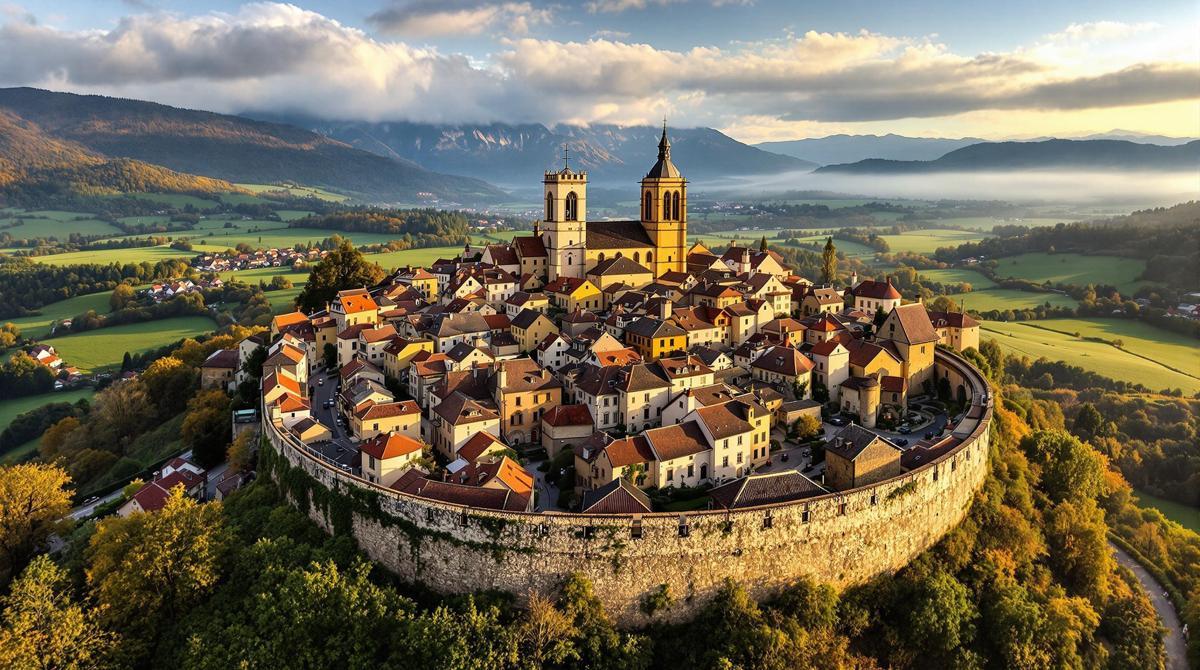Hidden in central France lies Charroux, a medieval gem that fewer than 320 people call home yet hosts thousands of visitors each year. This remarkable village, designated as one of “France’s Most Beautiful Villages” since 1987, transports travelers back in time while offering authentic artisanal experiences that larger tourist destinations simply cannot match.
A fortress town with stories etched in stone
Perched at 413 meters elevation in France’s Allier department, Charroux commands spectacular panoramic views. To the north stretches the fertile Limagne plain, while the majestic Auvergne mountains rise dramatically to the south. This strategic location explains why this circular fortified town once wielded significant power as a royal fortress.
Walking through Charroux feels like stepping through a medieval history book. The cobbled streets still bear the names of ancient trades that once thrived here—Rue du Tanneur (Tanner’s Street) and Rue de la Corderie (Rope Maker’s Street)—revealing the village’s prosperous commercial past.
The mustard makers who revived a lost tradition
Charroux’s most famous export might surprise you: artisanal mustard. Dating back to 1790, this tradition was revived in recent decades by passionate local craftspeople. Today, the Moutarderie de Charroux produces rich, complex mustards using local Saint-Pourçain wines and traditional stone-grinding techniques.
“Our purple mustard, infused with red wine, represents centuries of Bourbonnais culinary tradition in one small jar,” explains Marie Delaneau, a third-generation mustard maker.
A village where artisans thrive
Beyond mustard, Charroux has become a haven for artisans practicing traditional crafts. The village hosts candle makers, soap artisans, potters, and glassworkers. Each August, the “Artists and Artisans Day” transforms the village into an open-air workshop where visitors can watch craftspeople create their wares.
For travelers seeking authentic souvenirs, these medieval workshops offer treasures far more meaningful than mass-produced trinkets found elsewhere.
Architectural treasures hiding in plain sight
The 12th-century Saint-Jean-Baptiste church stands as Charroux’s most impressive monument, featuring an unusual blend of Romanesque and Gothic elements. Its bell tower, visible from miles away, once guided travelers to this important stopping point along medieval trade routes.
Perhaps more fascinating is the village’s collection of over 300 ancient wells scattered throughout its narrow streets and hidden courtyards. Each tells a story of the village’s relationship with water in this elevated location.
The perfect day trip for digital nomads
For those working remotely while exploring France, Charroux offers an ideal day-trip escape. The village’s compact size means you can thoroughly explore it in a few hours, making it perfect for those based in nearby Clermont-Ferrand or Vichy.
“I came expecting to spend an hour here, but the village captivated me for the entire day,” shares American travel photographer James Maxwell. “Every corner reveals another perfectly preserved slice of medieval France.”
When to visit (and how to avoid the crowds)
While some Mediterranean destinations might offer more reliable weather, Charroux is at its most enchanting during late spring and early fall. The summer months bring more tourists, but even then, this hidden gem receives far fewer visitors than similar villages in Provence or the Loire Valley.
For a truly magical experience, visit during the December Christmas market when locals decorate the medieval streets with thousands of candles, creating a fairytale atmosphere that would make even the most jaded traveler believe in magic again.
A gateway to explore central France
Charroux serves as an excellent starting point for exploring other hidden medieval treasures in central France. The regions of Auvergne and Bourbonnais remain delightfully undiscovered by international travelers, offering authentic experiences for those willing to venture beyond the standard French itinerary.
For adventurous travelers seeking environments beyond Europe, desert landscapes in other parts of the world offer striking contrasts to Charroux’s verdant surroundings.
Charroux reminds us that sometimes the most extraordinary travel experiences come in the smallest packages. This pocket-sized medieval marvel proves that France’s true magic often lies far from its crowded capitals and coastlines—in places where time moves more slowly, and traditions endure with quiet dignity.
